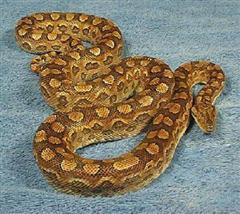Boa - Argentine Rainbow
Slender Argentinian Rainbow Boa Scientific Name: Epicrates cenchria alvarezi
Mon, 28th April, 2025 - 8:42 am GMT
Sponsor Ads:

Alternative Name
Slender Argentinian Rainbow Boa Scientific Name: Epicrates cenchria alvareziBasic Info
The Argentinian Rainbow Boa is a little more slender than the average Rainbow Boa, and has sometimes been called Slender Rainbow Boas. They grow to be about 6 feet in length. The scale pattern is generally set on a background of lighter brown or gray shades, which may be tinted with orange hues. Due to oddly textured scales, these Boas are so brightly colored because they shimmer. A pattern of rings and spots is clearly seen atop the background scale color and in Argentinian Rainbow Boas, this pattern is very intricate and elaborate. Females are larger than males and it is difficult to sex young Boas externally. Probing is the most common method used in sexing them.
Health
Argentinian Rainbow Boas do not require such high humidity or temperatures as many other subspecies of Rainbow Boas. The ambient daytime cage temperature should be close to 80 degrees with a warmer area of the cage about 85-90 degrees. At night, the temperature should drop to about 75 degrees Fahrenheit. Provide a water dish large enough for the snake to soak in and keep water available at all times as adult Argentinian Rainbow Boas tend to drink very large amounts of water daily. It is very important that these Rainbow Boas have many limbs to climb on in addition to a dark hiding place. Improper environmental conditions or excessive handling and stress can cause Argentinian Rainbow Boas to stop eating. Breeding Male Argentinian Rainbow Boas will have a probing distance of eight to twelve scales, while females will probe 2 to 4 scales. Male Argentinian Rainbow Boas also tend to have thicker tail bases and larger spurs than do females. Argentinian Rainbow Boas usually breed every other year in captivity. Only healthy, large animals should be bred, as it is quite stressful. Males reach sexual maturity at about 3 years of age and females at 4 to 5. Argentinian Rainbow Boas are not seasonal breeders. Standard cooling methods are necessary, however, in order for the snakes to form healthy egg and sperm cells. The gestation period is four to five months and Argentinian Rainbow Boas who are gravid require a much warmer basking spot, usually about 90 degrees, with the rest of the tank cooler. Gravid females do not eat very much, if at all. Usually Argentinian Rainbow Boas become very restless before laying, and while laying it is essential that they are not disturbed. They will eat stillborn slugs, and it is recommended to remove the live newborns immediately so they are not eaten by mistake. A typical litter includes 12 to 25 babies. Argentinian Rainbow Boa newborns need lots of food and should be fed once every few days. Approximately 2 weeks after birth, the infants will shed for the first time, and will continue to grow rapidly, often reaching 4 feet in length at one year of age.Habitat
Humid forests of South America,Behavior
The beautiful Argentinian Rainbow Boa is just one of nine subspecies of Rainbow Boas, which are often kept in captivity. With its long, slender body and strikingly patterned scales, it isn't hard to see why the Argentinian Rainbow Boa is such a popular pet. Native to the humid forests of South America, the Rainbow Boa is a nocturnal hunter. These Boas are a bit difficult to keep in captivity and must have carefully regulated temperature, light and humidity, and they are not recommended as a beginner's snake. Newborn Argentinian Rainbow Boas eat and grow at amazing rates, and are generally nervous and hyper. These young Rainbow Boas can be made tolerant of people through frequent and patient handling.Origin
South AmericaHistory
Argentinian Rainbow Boas are not quite as common as Brazilian Rainbow Boas but are gaining popularity and are by no means uncommon as captive snakes.Common Foods
N/ASponsor Ads:
The only imperfect thing in nature is the human race. -- Unknown
Boa - Argentine Rainbow
Coded by: BGID® | ALL RIGHTS RESERVED Copyright © 2000-2025
Disclaimer | Privacy | Report Errors / Contact | Credits








 President of the United States of America - Real Estate mogul, Pageant owner and now one of the most controversial men in political history.
President of the United States of America - Real Estate mogul, Pageant owner and now one of the most controversial men in political history.  Politician, US Vice President and President of the USA - Joseph Robinette Biden Jr.
Politician, US Vice President and President of the USA - Joseph Robinette Biden Jr.  versus
versus  Russia: 'The Evil Empire'? Are they all that bad or is it just the USA trying to portray Russia as bad because they are a world power with land bigger and a society very different from the USA ideal?
Russia: 'The Evil Empire'? Are they all that bad or is it just the USA trying to portray Russia as bad because they are a world power with land bigger and a society very different from the USA ideal?  Global warming has been in and out as the "latest" hot topic for many years. It is, according to modern scientists, the result of man-made industrial pollutants, clearing forested areas, agriculture, etc. But now they are thinking it started way before the Industrial Revolution...
Global warming has been in and out as the "latest" hot topic for many years. It is, according to modern scientists, the result of man-made industrial pollutants, clearing forested areas, agriculture, etc. But now they are thinking it started way before the Industrial Revolution... 
 Corona virus
Corona virus 
 Users with wide screen monitors can benefit from more content on every page.
Users with wide screen monitors can benefit from more content on every page.